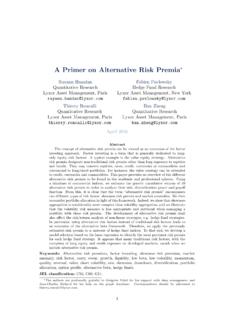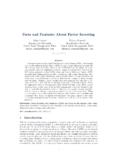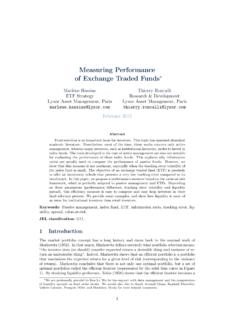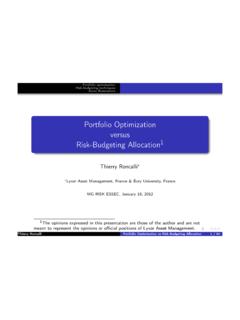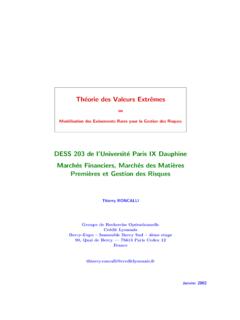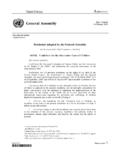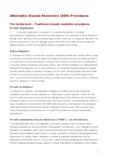Transcription of Alternative Risk Premia: What Do We Know? - …
1 Alternative Risk premia : what Do We Know? Thierry RoncalliQuantitative ResearchAmundi Asset Management, 2017 AbstractThe concept of Alternative risk premia is an extension of the factor investing ap-proach. Factor investing consists in building long-only equity portfolios, which aredirectly exposed to common risk factors like size, value or momentum. Alternative riskpremia designate non-traditional risk premia other than a long exposure to equities andbonds. They may involve equities, rates, credit, currencies or commodities and corre-spond to long/short portfolios. However, contrary to traditional risk premia , it is moredifficult to define Alternative risk premia and which risk premia really matter. In fact,the term Alternative risk premia encompasses two different types of systematic riskfactor: skewness risk premia and market anomalies.
2 For example, the most frequentalternative risk premia are carry and momentum, which are respectively a skewness riskpremium and a market anomaly. Because the returns of Alternative risk premia exhibitheterogeneous patterns in terms of statistical properties, option profile and drawdown,asset allocation is more complex than with traditional risk premia . In this context, riskdiversification cannot be reduced to volatility diversification and skewness risk becomesa key component of portfolio optimization. Understanding these different concepts andhow they interconnect is essential for improving multi-asset : Alternative risk premium, factor investing, skewness risk, market anomalies,systematic risk factor, diversification, carry, momentum, value, low beta, short volatility,payoff function, Alternative beta, hedge funds, multi-asset classification:C50, C60, IntroductionAfter the emergence of risk-based investing, factor investing has been the new hot topic inthe asset management industry since the 2008 Global Financial Crisis.
3 The two concepts arerelated to the notion of diversification, but take different standpoints. The goal of risk-basedinvesting is to build a better diversified portfolio than a mean-variance optimized idea is that mathematical optimization and volatility minimization do not always leadto financial diversification. The aim of factor investing is to extend the universe of assets forbuilding a diversified allocation by capturing systematic risk factors. For instance, in the This survey has been prepared for the bookFactor Investing and Alternative Risk Premiaedited byEmmanuel Jurczenko. It is extensively based on my previous three co-authored articlesFacts and FantasiesAbout Factor Investing,A Primer on Alternative Risk PremiaandRisk Parity Portfolios with SkewnessRisk: An Application to Factor Investing and Alternative Risk premia . I am profoundly grateful to Em-manuel Jurczenko, Didier Maillard, Bruno Taillardat and Ban Zheng for their helpful Risk premia : what Do We Know?
4 Equity space, the capital asset pricing model has been supplemented by a five-factor model,which is based on size, value, momentum, low beta and quality risk concept of Alternative risk premia (ARP) is an extension of factor investing, whichis a term generally reserved for long-only equity risk factors. Indeed, Alternative risk pre-mia concern all the asset classes, not only equities, but also rates, credit, currencies andcommodities. Moreover, they may be implemented using long/short portfolios. To be moreprecise, a risk premium is compensation for taking a risk that cannot be hedged or diver-sified. Traditionally, we consider that there are two main risk premia , which correspond toa long exposure to equities and bonds. However, since the eighties, academics have shownthat there are other sources of risk premia . For instance, cat bonds must incorporate arisk premium, because the investor takes a large risk that cannot be diversified.
5 Therefore, Alternative risk premia designate all the risk premia other than a long exposure to equitiesand to traditional risk premia , whose risk/return profile is relatively easy to un-derstand, the behavior of Alternative risk premia is more heterogeneous. In fact, they covertwo main categories of strategies: skewness risk premia and market anomalies. Skewnessrisk premia are pure risk premia , meaning that they reward systematic risks in bad , market anomalies are strategies that have performed well in the past, but thisperformance cannot be explained by the existence of a risk premium. For example, mo-mentum and trend-following strategies are market anomalies, whereas carry strategies aregenerally considered as skewness risk premia . As a result, statistical properties and optionprofiles are different from one risk premium to another.
6 In particular, skewness risk premiamay exhibit a high skewness risk. Whereas portfolio allocation between traditional risk pre-mia is usually based on expected returns and the covariance matrix, portfolio managementcannot ignore the third statistical moment. This issue is particularly important, becausesome investors see portfolios of alternatives risk premia as all-weather strategies. However,this is not the case in is the primary objective when investing in Alternative risk premia . Thesecond motivation is the search for higher returns, especially in a low-rate environment. Inthis context, Alternative risk premia are performance assets, and not only diversificationassets. It is therefore natural that the development of Alternative risk premia impacts thehedge fund industry. First, it offers a new framework for analyzing the risk/return profileof hedge fund strategies and institutional portfolios invested in Alternative assets.
7 Second,it provides new investment products that replicate the Alternative beta of hedge the most significant influence of Alternative risk premia certainly involves multi-assetmanagement, which cannot be reduced to an allocation between stocks and bonds. Indeed, Alternative risk premia constitute the other building blocks of multi-asset portfolios. Thisis why they participate in the convergence of traditional and Alternative chapter is organized as follows. In section two, we present the rationale of alterna-tive risk premia , in particular the difference between systematic, arbitrage and specific riskfactors. The study of factor investing in the equity market also helps in understanding themotivations behind the emergence of this new framework. In section three, we define moreprecisely the concept of Alternative risk premia and make the distinction between skewnessrisk premia and market anomalies.
8 We can then review the different generic strategies. Inparticular, carry and momentum are the two most relevant Alternative risk premia acrossthe different asset classes. Section four deals with the issue of diversification and portfoliomanagement in the presence of skewness risk. Finally, section five offers some Risk premia : what Do We Know? 2 The rationale of Alternative risk premiaIn order to understand the relationship between Alternative risk premia and the concept ofdiversification, we have to go back to the works of Markowitz (1952) on this topic. In a firststep, we show that diversification depends on the allocation model, but also on the definitionof the common risk factors. In a second step, using the results on the equity asset class, weshow that common risk factors are the only bets that are compatible with Difference between common risk factors and arbitrage factorsWe consider a universe ofnassets.
9 Let and be the vector of expected returns and thecovariance matrix of asset returns. We denote byx= (x1,..,xn) the vector of weights in theportfolio. For Markowitz (1952), the financial problem of the investor consists in maximizingthe expected excess return of his portfolio subject to a constraint on the portfolio s volatility:x?=arg maxx>( r1) x> x ?(1)whereris the return of the risk-free asset. Markowitz (1956) showed that this non-linearoptimization problem is equivalent to a quadratic optimization problem:x?= arg min12x> x x>( r1)(2)where is a parameter that controls the risk aversion of the investor. Without any con-straints, the mean-variance optimized (MVO) portfoliox?is equal to 1( r1). Moregenerally, in the presence of linear equality and inequality constraints, MVO portfolios areof the following form:x? f( , 1)(3)wherefis a complicated function that depends on the constraints.
10 More precisely, thesolution of the Markowitz optimization problem depends on the inverse of the covariancematrix and not the covariance matrix itself. Therefore, the important quantity in portfoliooptimization is the information matrixI= order to better understand the notion of information matrix, we consider the eigen-decomposition of the covariance matrix : =V V>(4)whereVis the matrix of eigenvectors of and is the diagonal matrix, whose elementsare the eigenvalues of . We have: 1=(V V>) 1=(V>) 1 1V 1=V 1V>(5)becauseVis an orthogonal matrix. It follows that the eigenvectors of the information matrixIare the same as those of the covariance matrix. This is not the case of eigenvalues. Indeed,the eigenvalues ofIare the inverse of the eigenvalues of .3 Alternative Risk premia : what Do We Know? Figure 1: Eigenvalues of covariance and information matrices of stock returns (FTSE 100index, June 2012)In Figure 1, we consider the one-year empirical covariance matrix of stock returns thatmade up the FTSE 100 index in June 2012.
